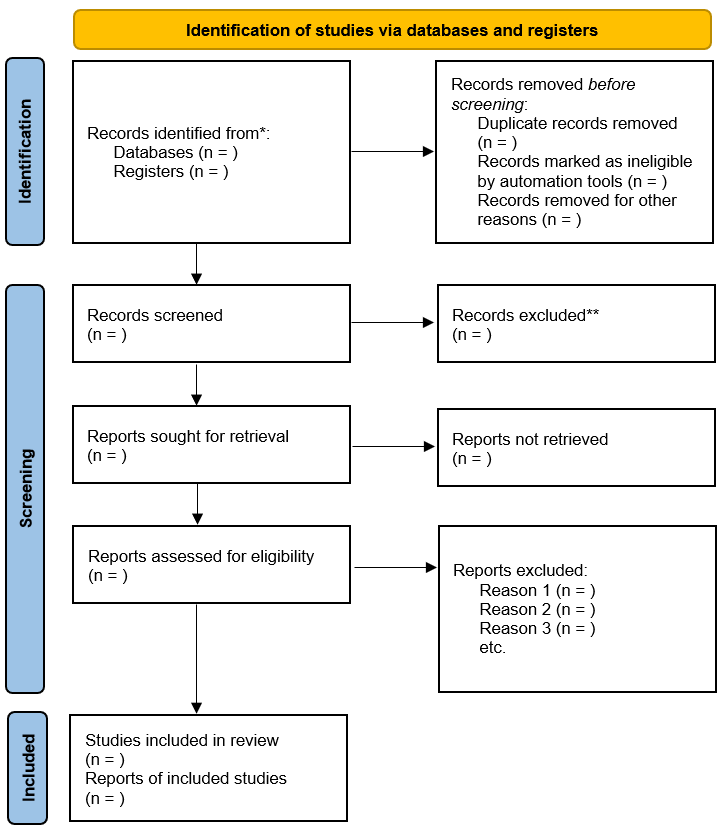What is PRISMA?
Published for the first time in 2009, “Preferred Reporting Items for Systematic Reviews and Meta-Analyses: The PRISMA Statement” (Moher et al., 2009) provides succinct and (relatively) manageable guidance for structuring, and therefore conducting, Systematic Reviews and Meta Analyses. Evinced by the primary image on its Wikipedia page, PRISMA is known for its flow diagram, where authors illustrate the systematic process of screening all search results for inclusion in two successive rounds. However, PRISMA is much more than its flow diagram, however fun it may be to read.
PRISMA 2020 Flow diagram

“PRISMA 2020 flow diagram for new systematic reviews which included searches of databases and registers only” from Page et al., 2021a
As its name makes clear, PRISMA provides 27 “reporting items” for researchers conducting Systematic Reviews and Meta-Analyses- essentially an item by item framework for your manuscript. If authors consult PRISMA from the start of their review process, they should find that reporting each item is manageable and produces a highly transparent review. Since its initial publication in 2009, PRISMA has been updated once- “The PRISMA 2020 statement: an updated guideline for reporting systematic reviews” was published in 2021 (Page et al., 2021a)- and has led to many extensions and translations.
PRISMA-Statement.org: What’s available?
Jointly sponsored by the Ottawa Hospital Research Institute, the University of Oxford, and Monash University, PRISMA-Statement.org is essentially a clearinghouse for all materials in the PRISMA family. The homepage as well as the “PRISMA STATEMENT” tab provide links to important materials related to the current PRISMA statement: downloadable checklists and flow diagrams, as well as the statement itself and- importantly- “PRISMA 2020 explanation and elaboration: updated guidance and exemplars for reporting systematic reviews” (Page et al., 2021b). This “E & E” document provides expanded explanations and examples for each of the 27 reporting items in the PRISMA checklist. Each example comes from a published paper, which readers may link out to for more context.
In addition to making the current PRISMA materials available, PRISMA-Statement.org has five additional tabs: EXTENSIONS, TRANSLATIONS, PROTOCOLS, ENDORSEMENT, and NEWS. While the NEWS tab does not have recent updates, the EXTENSIONS and TRANSLATIONS tabs are kept up to date. The TRANSLATIONS tab provides downloadable versions of the checklist and other materials that have been translated into languages other than English.
Extensions to PRISMA are essentially modifications of the traditional PRISMA guidelines for different review and publication types. There are currently 11 extensions listed and linked, as well as a link to extensions in development. Of particular interest is the PRISMA for Scoping Reviews extension, as this publication type is gaining popularity in a variety of fields. The documentation for this extension, PRISMA-ScR for short, consists of the checklist of reporting items, the flow diagram, extensive fact sheets, a video, and the statement itself (Tricco et al., 2018).
The newest extension is of particular interest to librarians: PRISMA for Searching. This statement and its corresponding checklist of 16 reporting items was published in 2021 and provides guidelines specifically for the Systematic Review search process (Rethlefsen et al.).
Why use PRISMA-Statement.org?
The PRISMA Statement, its 2020 update, and its many extensions and translations are published and produced by a variety of different authors and groups, in a variety of different journals and institutional websites. PRISMA-Statement.org is a simple and free place to access all of this material in one place. As more extensions are developed and published, researchers conducting reviews should check PRISMA-Statement.org for current reporting guidelines that most closely match their review type. In addition to making the Systematic, Scoping, Rapid, etc. review processes more straightforward, PRISMA reporting is encouraged by many journals in the Health Sciences that accept reviews for publication.
Bibliography
Moher, D., Liberati, A., Tetzlaff, J., Altman, D. G., & PRISMA Group*, T. (2009). Preferred reporting items for systematic reviews and meta-analyses: the PRISMA statement. Annals of internal medicine, 151(4), 264-269.
Page M J, McKenzie J E, Bossuyt P M, Boutron I, Hoffmann T C, Mulrow C D et al. (2021a). PRISMA 2020 explanation and elaboration: updated guidance for reporting systematic reviews. BMJ, 372(71), doi: 10.1136/bmj.n71.
Page M J, Moher D, Bossuyt P M, Boutron I, Hoffmann T C, Mulrow C D et al. (2021b). PRISMA 2020 explanation and elaboration: updated guidance and exemplars for reporting systematic reviews BMJ, 372(160), doi:10.1136/bmj.n160.
Rethlefsen ML, Kirtley S, Waffenschmidt S, Ayala AP, Moher D, Page MJ, Koffel JB; PRISMA-S Group. (2021). PRISMA-S: an extension to the PRISMA Statement for Reporting Literature Searches in Systematic Reviews. Syst Rev, 10(1):39. doi: 10.1186/s13643-020-01542-z. PMID: 33499930; PMCID: PMC7839230.
Tricco, AC, Lillie, E, Zarin, W, O’Brien, KK, Colquhoun, H, Levac, D, Moher, D, Peters, MD, Horsley, T, Weeks, L, Hempel, S et al. (2018). PRISMA extension for scoping reviews (PRISMA-ScR): checklist and explanation. Ann Intern Med, 169(7):467-473. doi:10.7326/M18-0850.
Samantha Walsh, Research Services Librarian, Hunter College, City University of New York
We welcome your comments and suggestions. If you have a resource that you would like to see highlighted please leave us a comment.

